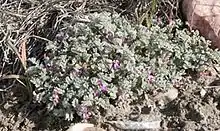| Goose Creek milkvetch | |
|---|---|
 | |
| Scientific classification | |
| Kingdom: | Plantae |
| Clade: | Tracheophytes |
| Clade: | Angiosperms |
| Clade: | Eudicots |
| Clade: | Rosids |
| Order: | Fabales |
| Family: | Fabaceae |
| Subfamily: | Faboideae |
| Genus: | Astragalus |
| Species: | A. anserinus |
| Binomial name | |
| Astragalus anserinus Atwood, Goodrich, & Welch | |
Astragalus anserinus, also called the Goose Creek milkvetch, is a member of the genus Astragalus that is listed as a candidate species under the Endangered Species Act. It grows in a 10-square-mile (26 km2) area of the Goose Watershed of the Upper Snake Basin in Idaho, Nevada and Utah.[2][3][4]
References
- ↑ "NatureServe Explorer". NatureServe Explorer Astragalus anserinus. NatureServe. 2022. Retrieved 22 May 2022.
- ↑ John Platt (Sep 14, 2009). "Rare plant worthy of Endangered Species Act protection--But won't get it". Scientific American.
- ↑ U.S. Fish and Wildlife Service (September 10, 2009). "Milkvetch Warrants Endangered Species Act Protection But Listing Precluded By Other Priorities". U.S. Fish and Wildlife Service.
- ↑ "USDA Plants Database".
External links
- The Nature Conservancy
- Atwood, N. D., et al. (1984). New Astragalus (Leguminosae) from the Goose Creek drainage Utah-Nevada. Great Basin Naturalist.
This article is issued from Wikipedia. The text is licensed under Creative Commons - Attribution - Sharealike. Additional terms may apply for the media files.
